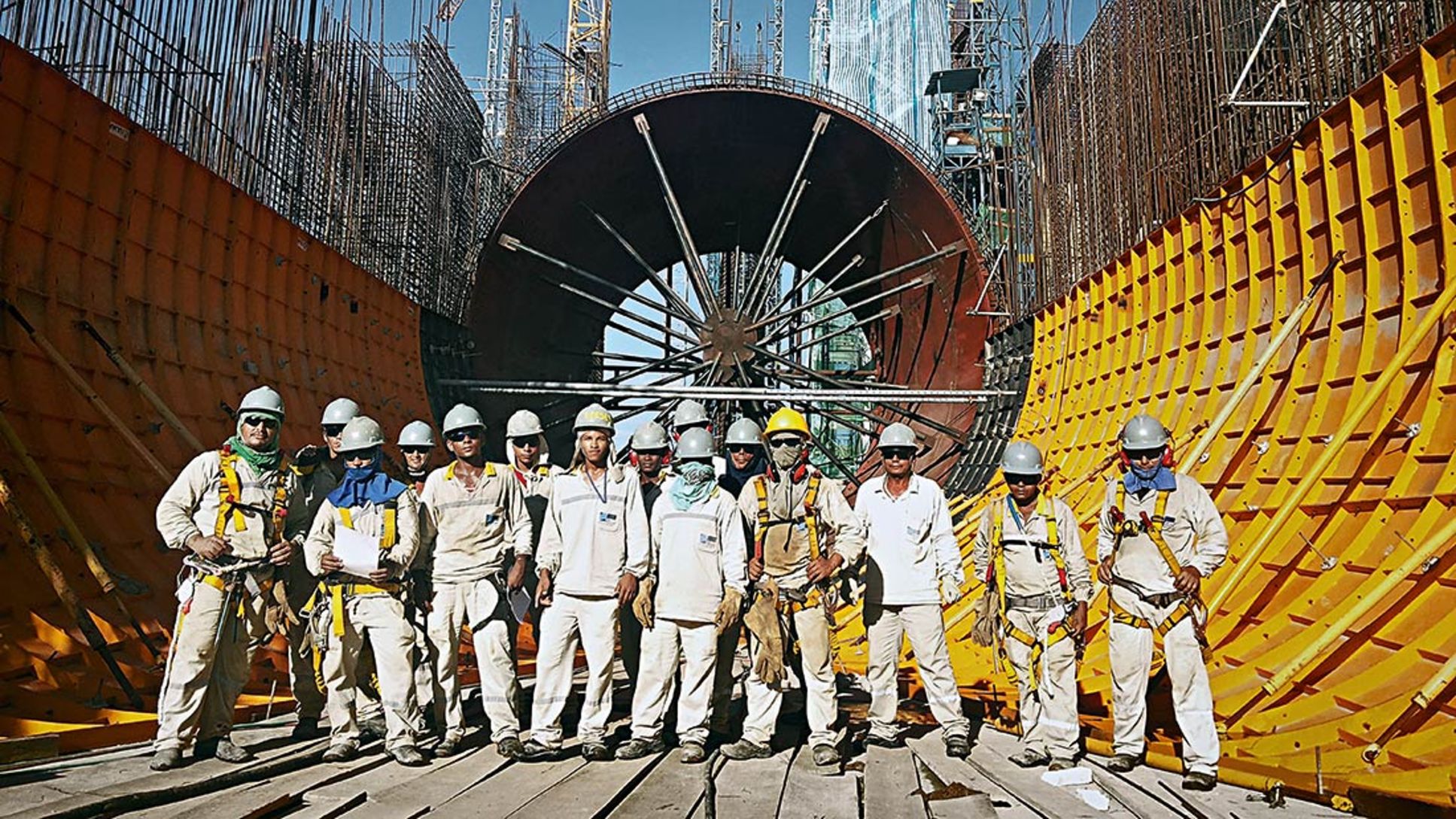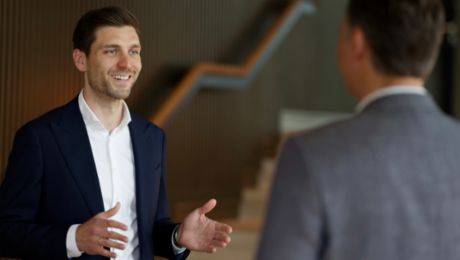The rules of lean production are being applied to one of the largest construction sites in the world: the Belo Monte Dam in Brazil. In the middle of the Amazon rainforest, Porsche consultants are working with the employees of a construction consortium made up of ten different corporations in order to prevent the waste of time and materials.
Belo Monte, or “beautiful mountain,” is the furthest outpost from civilization at which Porsche consultants have ever worked. The “mountain” itself is not particularly imposing. Far more impressive than this hill in the Belo Monte region is the valley of the Rio Xingu, a tributary of the Amazon. Also eye-catching are the gigantic construction sites.
The reason why Senior Expert Arlan Cardoso and his team of consultants are sweating away deep in the jungle is because one of the largest dams of all time is being built in this remote part of the Brazilian state of Pará to create a reservoir for the third-largest hydroelectric plant in the world. As of 2019, the turbines for the Usina Hidrelétrica de Belo Monte are expected to produce up to eleven gigawatts at peak times, which is nearly as much as the combined output of all nuclear power stations still operating in Germany. The main investor in this project is the Norte Energia operating company.
Just-in-time-method increases productivity
The designation for the consultants’ area of expertise—lean construction—could hardly contrast more sharply with the enormous dimensions of the cement structures designed to hold up to four billion cubic meters of water: a complex of dam walls, dikes, and canals that is one of the most massive projects in human history since the pyramids. The workers will have to handle 3.3 million cubic meters of cement.
When Cardoso talks about “lean” construction, he doesn’t mean a new type of design principle from the architects or civil engineers, but a philosophy of lean production that can also be applied to the operating processes at construction sites. For example, cement trucks should not be loaded at a shorter takt than they can be unloaded at the three major construction sites.
“Cement that was mixed and ready for use would sometimes stand too long in the heat,” says Cardoso’s boss Rüdiger Leutz. “It would dry out and harden, and the only thing you could do then was discard it.” So the just-in-time method is not only increasing productivity, but also preventing the waste of materials that are environmentally harmful as well as the waste of time spent redoing various jobs that could disrupt the schedule.
Methods from the automotive industry could be adapted
Lean construction is a high-growth area of activity for Porsche Consulting, and by far the largest focus of the company’s Brazilian subsidiary. It accounts for 80 percent of the turnover for Leutz and his team of consultants. “We had contact with the construction industry back in 2010, but were not focusing on it at that time,” says Leutz, a native of Germany who has lived in Brazil since 2008 and headed the Porsche Consulting office in São Paulo since 2013.
The expansion of a container port in Rio de Janeiro offered an opportunity to become involved in a large-scale project in this sector. Commissioned by Andrade Gutierrez, one of the leading construction groups in Latin America, the Porsche experts introduced a takt principle into the work processes there. This initial joint project was enough to convince the company that the proven methods from the automotive industry could be adapted to considerable benefit for the construction industry.
Marco Túlio Pinto from Andrade Gutierrez is in charge of building the dam for the Consórcio Construtor Belo Monte (CCBM ). This consortium, led by his employer, is building the cement structures, namely, the dam walls, inlet canals, and power stations in the Belo Monte and Pimental areas. There is far more at stake for this project than for the one in Rio. That is why Andrade Gutierrez secured the support of the Porsche consultants for Belo Monte as well—in all areas of construction.
“Working in the hot climate of the Amazon is a challenge.”
The partner companies are not dividing up the tasks and tackling them separately, but rather are working together on mixed teams. This is how Cardoso’s group came to be showing the principles of lean construction to managers and workers of Brazil’s three largest construction groups at once. In addition to the consultants’ immediate client—currently number three on the market—the consortium’s partners include the next largest company Camargo Corrêa as well as Odebrecht, the industry giant.
The consultants are working under conditions that give pause to Brazilians as well. “Any type of work in the hot and humid climate of the Amazon is a challenge,” says Project Director Túlio Pinto. But it’s even more difficult to picture in your mind what can be done in the middle of the wilderness to institute a culture of operational excellence by means of lean construction and continuous improvement, with the goal a general code of practice that 30,000 people can follow. And that, in brief, is an ambitious aim.
That is also the job of Senior Expert Arlan Cardoso, who must seem like someone from another world to many of the people he meets. “Most people here have never imagined they would one day be working together with business consultants,” he observes.
The rules for the workers need to be straightforward
The participants in his workshop program range from highly educated construction engineers to temporary workers who have been recruited locally and trained on the job. “Some of the employees grew up in remote villages and have very little formal education,” says Leutz. “We were commissioned because we made it plain that we could qualify these individuals as well.” And because they do it right on the construction site.
But how does one show people who have never really lived by the clock and whose culture has a certain fondness for the word amanhã (“tomorrow”) that it is important to complete their tasks “just in time”? “We don’t try to transfer our models one-to-one, of course,” says Leutz. “We adapt them and apply them in specific ways to make them feasible and reasonable in the Amazon.” This means a minimum of theory, lots of diagrams, and a suitable takt. In a place where people’s lives are structured by the simple succession of day and night, what makes sense is a rhythm based on days.
Measuring progress in shorter intervals doesn’t work, and longer intervals are too risky in Leutz’s eyes. In the evenings the experts determine whether each team has completed its quota for the day, or where there might be problems. At workshops and on sites, young construction engineers follow them around in order to learn what shop-floor management means. The rules that they give the workers need to be straightforward. Ultimately, the training should continue to yield results even after the Porsche consultants have left.
Several nuclear plants needn't be built
The history of the Belo Monte Dam started back in the 1970s. The military junta at the time envisioned filling the Amazon with hydroelectric stations—with no thought of the environmental or social consequences. For decades, representatives of the government, environmental groups, and indigenous peoples struggled to reach a solution—both politically and in court. The state made ever more cuts to its original plans. The reservoir planned today will be roughly the size of Lake Constance, as opposed to an area ten times larger. Norte Energia is promising that not an inch of land belonging to indigenous peoples will be flooded, and is also funding wildlife conservation projects, for some unusual species live in the Rio Xingo.
The project does not enjoy unanimous support among NGOs. But the hydroelectric power station will save this ambitious Latin American economy from having to build several nuclear plants. In contrast to the amount of land cleared in the Amazon for agricultural purposes, the area to be flooded for the dam is tiny. And the structures for the Belo Monte project also have a manageable total overall volume.
Marco Túlio Pinto is confident that lean construction will help to save materials and thereby also costs in the process of completing the mammoth dam. “We’ve been able to identify sources of waste and rejects in a number of stages—and thus raise the added value,” he says. For Leutz and Cardoso this compliment means a lot. For if you can do that in the middle of nowhere, you can do it anywhere.
Info
Text first published in „Porsche Consulting - THE MAGAZINE", Issue 15
Author: Ulf J. Froitzheim




